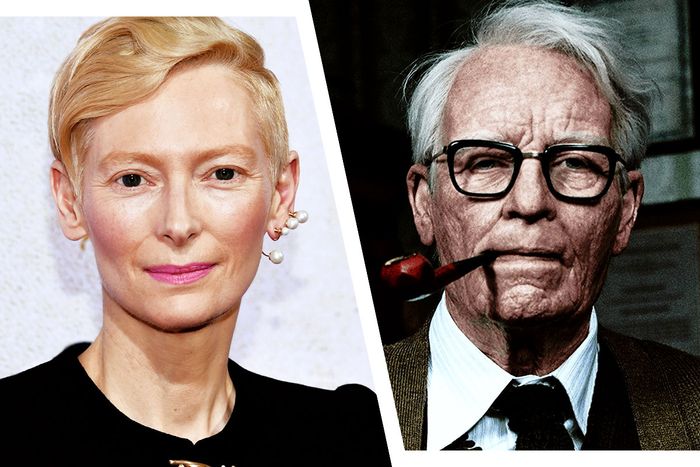
Early in the process of planning his remake of Dario Argento’s Suspiria, Luca Guadagnino and his muse Tilda Swinton were struck with inspiration. What if Swinton played not just Madame Blanc, the icy French witch at the center of the film’s Berlin coven, but also two other prominent roles in the script? On Swinton’s part, the gambit seems to have been undertaken mostly for the laughs, but for Guadagnino there was an additional resonance. As he explained to Vulture last month, in those three roles he saw the three Freudian archetypes. Blanc, who looks more or less like Swinton, is the ego; Mother Markos, a monstrous figure introduced at the end of the film, is the id; and elderly psychoanalyst Josef Klemperer (who production long maintained was being played by a newcomer called “Lutz Ebersdorf”) represented the superego.
Swinton, one of contemporary cinema’s most prominent shape-shifters, was up to the challenge. But equal weight for pulling off the stunt fell to Mark Coulier, the award-winning makeup artist who oversaw the creation of Lord Voldemort in the Harry Potter films. Luckily, Coulier had worked with Swinton before, aging up the Scottish actress into an elderly woman on The Grand Budapest Hotel, which won him his second Oscar. (The first came for turning Meryl Streep into Margaret Thatcher in The Iron Lady.) He came away praising Swinton’s enthusiasm, and endurance, for those types of roles. “Not all actors enjoy the difficulty of doing prosthetic work,” he said. “It’s not the most pleasant thing to sit in a chair for five hours and have latex stuck to your skin.” That’s a slight understatement; the first makeup tests for Grand Budapest took ten.
On Suspiria, Coulier and his team had a luxury every Hollywood craftsman dreams of — time. The first makeup test for Swinton’s transformation into Ebersdorf started 18 months before filming began, just to see if Guadagnino’s dream was even possible. It was, but the challenges were legion: The actress’s long, avian frame didn’t exactly lend itself to playing a male octogenarian, and much of the initial work was spent counteracting her elegant bone structure. Coulier thickened her jawline, gave her new ears, and a little bit of a paunch. Swinton also gave some input on how the character’s mouth could be changed to make it easier for her to talk.
Those initial tests were followed by months of experimentation to get the character looking as realistic as possible. Besides tinkering with the lips and jaw, which sculptor Josh Weston eventually perfected, the main difference was Klemperer’s skin, which got more detailed as the team painstakingly researched physical marks of aging. (Visual references helped: “You can’t always remember what liver spots look like.”) On Swinton’s request, the doctor also got a makeover to look slightly more Teutonic, though here Coulier eschewed the “heavy bone structure of the Eastern Bloc” in favor of a more holistic sense of German-ness. “I literally just Googled ‘German psychoanalysts,’” he said. “If you look at them, you will probably see a bit of Lutz Ebersdorf in there.”
Subtle alterations, like raising the eyebrows in the center, helped give Klemperer’s face the right emotional timbre. Though not too much — makeup artists are careful to give their prosthetics as neutral an expression as possible. In the final result, Coulier says, “Klemperer No. 2 looks a bit more like he’s had a life. He’s lived in this world of sadness. He has that air of melancholy.”
To complete the illusion, Swinton requested the makeup team craft Ebersdorf a set of prosthetic male genitalia — the penis de résistance. “It’s a bit like Robert De Niro wanting to wear silk underwear when he played Al Capone,” Coulier said. “She wanted to feel that weight between her legs.” The silicone piece was apparently much less detailed than the rest of Swinton’s makeup, unwelcome news for the nosy reporter hoping to get all the details he could about the fake penis, but the artist did reveal that it leaned a little to the side.
If the Lutz Ebersdorf makeup required Swinton’s essence to still shine through, the actress’s third role in the film was another level of transformation entirely. Dance academy founder Helena Markos is a lingering presence throughout Suspiria, and when she finally makes her entrance in the film’s showstopping final sequence, she’s revealed as an unholy aberration, a living corpse cursed by the magic that’s keeping her alive. “It wasn’t about taking Tilda and exaggerating her,” Coulier says of the Markos job. “There’s really no resemblance.”
With the basic look inspired by a photograph Guadagnino had found of an old woman grinning under large black sunglasses, the team set about trying to make Markos as disgusting as possible. “Luca said, ‘I want her body to be corrupted, postulating with disease, and falling apart,’” Coulier recalled. “He wanted her face to be really twisted and deformed.” The Ebersdorf makeup was mostly made up of silicone pieces, but the Markos makeup was a full-foam latex monster suit, with a collection of horrific embellishments affixed to the outside. “Luca is a big fan of David Cronenberg, and he likes a bit of body horror,” Coulier said. “You’ve got to really extrapolate, then: ‘Does he really want her to look like a wide-mouth frog?’ He really does!”
Weston again handled the character’s face, nailing Markos’s toadlike visage in a few tries. The rest of the team set about adding all the little disgusting details that would make the character sing. Here there was no balancing act required; every time they ran a design by Guadagnino, he needed more, more, more. “However gross it was, Luca wanted it grosser.”
In the end, Markos’s skin would end up covered in internal organs, tumors, even a child’s arm. (The arm comes from a mold taken of Coulier’s own young son.) “Luca wanted everyone to walk out of the movie a bit stunned, and you do,” the makeup artist said. “Markos is a really shocking thing.”



